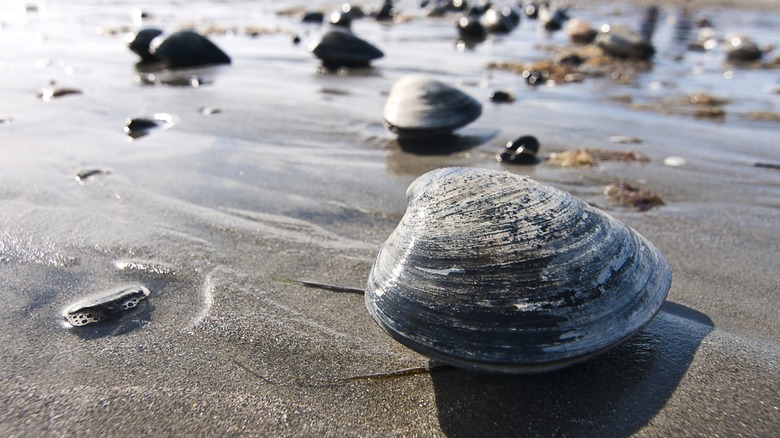A Clam Believed To Be Extinct For 40,000 Years Baffles Scientists With Its Reemergence
In November 2018, Jeff Goddard went to Naples Point, California, to look for nudibranch sea slugs in tidal pools. He found something else entirely: an animal that should have been long dead.
It was a translucent bivalve creature — which Britannica describes as an animal with a hinged shell and valves on each side — but when he saw its extremely long, striped feet, he realized it wasn't a species he knew. According to The Current, Goddard is a research associate at the Marine Science Institute at the University of California, Santa Barbara, and had been studying marine life at Naples Point for years.
He took pictures of the animal to show his colleague, Paul Valentich-Scott, curator emeritus of malacology at the Santa Barbara Museum of Natural History. Malacology is the study of mollusks — invertebrate marine animals (per the Burke Museum). Valentinch-Scott didn't recognize it either, and they searched the record of known bivalves until they found one that seemed to match: the cymatioa cooki clam, documented by George Willett in 1937. The strange part? Cymatioa cooki was believed to have been extinct for more than 40,000 years. A living one had never been documented (via Science News). Goddard confirmed this identification by comparing a specimen he caught in 2019 — after many tries — to the fossil Willett originally wrote about.
Willett's findings
Willett's 1937 article (beginning on page 379) appeared in the "Transactions of the San Diego Society of Natural History" journal and described different fossils found in Baldwin Hills, Los Angeles (pictured). They were specifically from the Pleistocene Era, which was between 11,700 and two million years ago, according to Britannica. Per The Current, Willett had never seen this type of clam himself, despite having examined an estimated one million fossils from Baldwin Hills. The cymatioa cooki samples came from an amateur shell collector, Edna Cook, for whom it was named. She had recognized the shells as something special (via Science News).
Willett described the clam's shell in detail in his article, helping the modern scientists make their identification. The size of his samples — averaging around 10mm in diameter — was also similar to the ones Goddard found, which were around 11mm (via Science News).
Willett's article established the age of the fossils and the fact that the species was probably extinct; he lists it as such with a few other species he studied.
Goddard's migration theory
How did these clams manage to hide from scientists for so long? Goddard told The Current that the Southern California coast is a "well-studied" area, making it even stranger that no one had seen a living cymatioa cooki in recorded history.
Goddard's theory is that they aren't native to the region. He thinks most members of the species probably live in the intertidal areas of Baja California, Mexico, specifically nestled under the many boulders there. Goddard and his colleagues have found two, possibly four, living cymatioa cooki specimens over the past few years, and he thinks those rare few made it to the Santa Barbara area when they were in their planktonic larvae form. Ocean currents probably brought them north during heatwaves between 2014 and 2016, he said. This happened to many marine animals at the time, and it would explain why Goddard never saw the clams at Naples Point earlier in his career.
He and Valentinch-Scott point out in their paper that the clams' small size and translucence make them hard to spot, which is probably another reason they haven't been found sooner. They hope more of the clams will be found in California and Mexico going forward.


